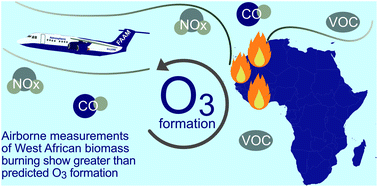Ozone production and precursor emission from wildfires in Africa†
Abstract
Tropospheric ozone (O3) negatively impacts human health and is also a greenhouse gas. It is formed photochemically by reactions of nitrogen oxides (NOx) and volatile organic compounds (VOCs), of which wildfires are an important source. This study presents data from research flights sampling wildfires in West and Central African savannah regions, both close to the fires and after the emissions had been transported several days over the tropical North Atlantic Ocean. Emission factors (EFs) in g kg−1 for NOx (as NO), six VOCs and formaldehyde were calculated from enhancement to mole fractions in data taken close to the fires. For NOx, the emission factor was calculated as 2.05 ± 0.43 g kg−1 for Senegal and 1.20 ± 0.28 g kg−1 for Uganda, both higher than the average value of 1.13 ± 0.6 g kg−1 for previous studies of African savannah regions. For most VOCs (except acetylene), EFs in Uganda were lower by factors of 20–50% compared to Senegal, with almost all the values below those in the literature. O3 enhancement in the fire plumes was investigated by examining the ΔO3/ΔCO enhancement ratio, with values ranging from 0.07–0.14 close to the fires up to 0.25 for measurements taken over the Atlantic Ocean up to 200 hours downwind. In addition, measurements of O3 and its precursors were compared to the output of a global chemistry transport model (GEOS-CF) for the flights over the Atlantic Ocean. Normalised mean bias (NMB) comparison between the measured and modelled data was good outside of the fire plumes, with CO showing a model under-prediction of 4.6% and O3 a slight over-prediction of 0.7% (both within the standard deviation of the data). For NOx the agreement was poorer, with an under-prediction of 9.9% across all flights. Inside the fire plumes the agreement between modelled and measured values is worse, with the model being biased significantly lower for all three species. In total across all flights, there was an under-prediction of 29.4%, 16.5% and 37.5% for CO, O3 and NOx respectively. Finally, the measured ΔO3/ΔCO enhancement ratios were compared to those in the model for the equivalent flight data, with the model showing a lower value of 0.17 ± 0.03 compared to an observed value of 0.29 ± 0.05. The results detailed here show that the O3 burden to the North Atlantic Ocean from African wildfires may be underestimated and that further study is required to better study the O3 precursor emissions and chemistry.

- This article is part of the themed collections: The role of tropospheric ozone in atmospheric processes, health and climate - Topic Highlight and Wildfire impacts on atmospheric composition - Topic Highlight


 Please wait while we load your content...
Please wait while we load your content...